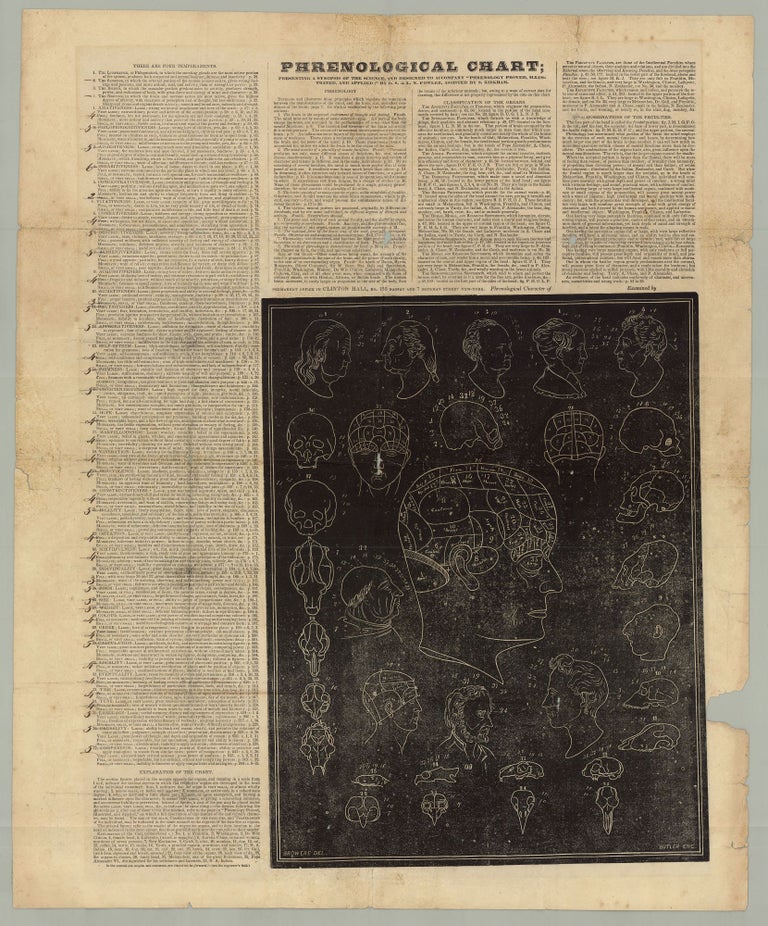Phrenological Chart; Presenting a Synopsis of the Science and Designed to Accompany “Phrenology Proved, Illustrated, and Applied” by O. S. and L. N. Fowler, Assisted by S. Kirkham.
New York, ca. 1837. Illustrated broadside, 21.5” x 16.125” plus margins. Text in four columns, with wood engraving (15.125” x 11.5”) in lower right. Filled out in ink in the left margin. CONDITION: Good, five 1” tears and one 1” x 1” chip to margins, no affect to contents; 4 small chips at folds with a few partial losses to words. A rare and visually striking chart from “the pre-eminent spokesmen for phrenology” in America. This chart was “designed to accompany” Orson Squire and Lorenzo Niles Fowler’s Phrenology Proved, Illustrated, and Applied (1836), and was issued separately from the book in 1837 from their new location at 135 Nassau Street. It offers a brief outline of the book and provides a detailed diagram of skulls and heads—both human and animal—labeled according to the Fowlers’ “classification of the organs” of the mind. The column bearing the heading “There are Four Temperaments” also contains brief descriptions of the thirty seven affective, intellectual, animal, “domestick,” selfish, moral, perceptive, and reflective faculties of the mind, along with their strength or weakness depending on the size of their respective organs (from “Very large,” or “Large,” to “Full, or Moderate” and “Small, or very small”). Each size is designated by a numerical score from seven, the largest, to 1, the smallest, and the chart is filled out for an unknown person who is apparently “sanguine” and “nervous,” and scored especially highly (a six) on “Inhabitiveness” or “love of home; desire to dwell in one place,” and rather low (a two) on “Concentrativeness” or “continuity and protraction of thought and feeling.” The Fowler brothers were the first to popularize phrenology in the United States, and their influence was enormous. “Everyone, from small-town folk to the rich and famous, sat for readings, including such notables as Horace Greeley…Brigham Young,” P. T. Barnum, Walt Whitman, and the young Clara Barton, as well as Mark Twain—who “recounted with horror that Fowler had found on his skull ‘a cavity’ where humor ought to be” and was accordingly skeptical of the ‘science’ (Morse). Orson Squire Fowler (1809–1887) encountered phrenology as a student at Amherst College, during the whirlwind American tour of Johann Kaspar Spurzhiem, the protégé of phrenology’s Viennese originator, Franz Joseph Gall. He and his brother Lorenzo Niles (1809–1887) began touring the country, lecturing and performing phrenological readings, and eventually went into business with their sister Caroline, Caroline’s husband, and Orson’s wife Lydia. AAS attributes the illustration to John Henri Isaac Browere (1790–1834), a painter and sculptor best known for his life masks of important 19th century figures, including Thomas Jefferson, Lafayette, and John Quincy Adams. According to David Ward, senior historian at the National Portrait gallery, “Thomas Jefferson endured a near-death experience during his sitting”: the artist “was distracted and left the plaster on too long. The elderly Jefferson, ever the gentleman, was too polite to tell Browere that he was having difficulty breathing. Jefferson’s daughters later accused Browere of trying to kill the president” (Lozano). Browere studied with Archibald Robertson in New York, where he spent most of his life except for a two-year stint in Europe to study sculpture and various U.S. excursions to make life casts. OCLC lists just five copies of this broadside, at Yale, New York Historical Society, NYPL, the Free Library of Philadelphia, and AAS. A phrenological chart by the brothers who popularized the ‘science’ in America, illustrated by an artist known for his life casts of major 19th century figures. REFERENCES: Morse, Minna Scherlinder. “Facing a Bumpy History: The much-maligned theory of phrenology gets a tip of the hat from modern neuroscience,” Smithsonian Magazine online; Lozano, Alicia. “Inside the art of life and death masks,” 16 July, 2014, WOTP News; “The Phrenology Exhibit,” The Lost Museum Archive online; Checklist of American Imprints, 41-1937.
Item #7434
Sold


